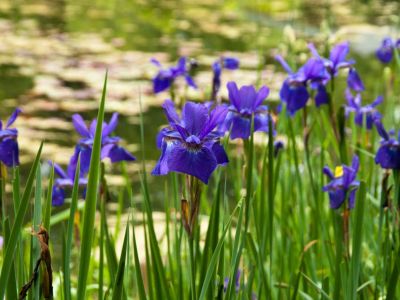While some are chosen for their beauty, other pond plants are necessary for a pond’s health. Below is a list of eight of the most popular pond plants in the United Kingdom and the United States, with information on why people love them and why our ponds need them.
Popular Pond Plants
- Albatross Water Lily – This beautiful water lily is, in my opinion, a must for most ponds. The Albatross is known for growing quickly so there is no need to overplant. They produce a huge number of leaves and stunning flowers all summer and can be placed in deeper areas of the pond. They should be planted in special containers with a good quality, loam-based pond soil and a slow-release water lily fertilizer. Do not plant too deep; leave part of the tuber free and top the basket up with gravel to help avoid tuber rot.
- Common Waterweed (Egeria densa) – This oxygenator pond plant is beneficial to the pond because it serves as a water purifier. It is a fast-growing plant that does best underwater. While you may not be able to enjoy its beauty on the surface like most plants, it serves a vital function, making it a very popular choice for ponds.
- Water Soldier (Statiotes aloides) – Coming from the family of floating pond plants, they do not require soil and their roots will simply float beneath them in the water. They are used for their spectacular decorative effect and can float anywhere in the pond and look great in clumps.
- Japanese Iris (Iris ensata) – An emerging marginal pond plant, this variety survives best around the edge of the pond where the water is around 6 inches (15 cm.) deep. Japanese iris will add gorgeous color to the perimeter of your pond, but they do not like to get totally wet, so they should be anchored with pebbles.
- Spike Rush (Eleocharis) – Also called Hair Grass, this is a favorite because it is hardy and easy to grow. It is a marginal plant and can be grown in a pond basket. Resembling tall grass, it survives best in shallower water and does great around the perimeter of the pond.
- Water Hyacinth (Eichhornia) – Another beautiful floating pond plant, its violet flowers will bloom when the temperature warms up. Water hyacinth likes full sun exposure and are known for growing very quickly.
- Sweet Flag (Acorus calamus) – This is a marginal plant and is characterized by tall, thick leaves that look like swords. Sweet flag should be planted in the shallower areas of a larger garden ponds and even does well in the muddier places. They will create a dense green thicket, ideal for edging the pond.
- Marsh Marigold (Caltha palustris) – One of the most ancient of British pond plants, it now comes in double flower varieties too, but I think the natural version is best. This marginal pond plant has gorgeous, bright yellow flowers. Marsh marigold will survive best if placed in the shallower waters of the pond. NOTE: The use of native plants in a home water garden (referred to as wild harvesting) can be risky if you have fish in your pond, as most natural water features are host to a plethora of parasites. Any plants taken from a natural water source should be quarantined overnight in a strong solution of potassium permanganate to kill any parasites prior to introducing them into your pond. That being said, it is always best to obtain water garden plants from a reputable nursery.
